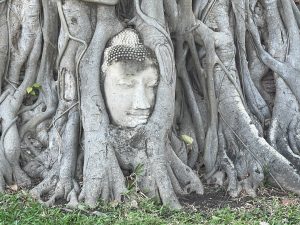
Ayutthaya became the second Siamese capital after Sukhothai. It was destroyed by the Burmese in the 18th century. Its remains, characterised by the prang (reliquary towers) and gigantic monasteries, give an idea of its past splendour. I visited this historical this UNESCO recognised heritage site in Thailand (near Bangkok) in February 2023, after missing a plan to visit the Angkor Wat temple complex in Cambodia.
It is necessary to know a bit about this heritage site.

Ayutthya photos by Shobhit Nanda & Neeraj Nanda for South Asia Times (SAT), Melbourne. Copyright protected.
The Historic City of Ayutthaya, founded in 1350, was the second capital of the Siamese Kingdom. It flourished from the 14th to the 18th centuries, during which time it grew to be one of the world’s largest and most cosmopolitan urban areas and a center of global diplomacy and commerce. Ayutthaya was strategically located on an island surrounded by three rivers connecting the city to the sea.

The city was attacked and razed by the Burmese army in 1767 who burned the city to the ground and forced the inhabitants to abandon the city. The city was never rebuilt in the same location and remains known today as an extensive archaeological site.
At present, it is located in Phra Nakhon Si Ayutthaya District, Phra Nakhon Si Ayutthaya Province. The total area of the World Heritage property is 289 ha.

Ayutthya photos by Shobhit Nanda & Neeraj Nanda for South Asia Times (SAT), Melbourne. Copyright protected.
There is so much to see, observe and understand. Me and Shobhit Nanda moved around for half a day in scorching sun taking photos. The rather mesmerising archeological structures are a tribute to human kinds quest for what we are amidst the wonder that is mother Earth. The tall prang (reliquary towers) and Buddhist monasteries create an ambience of eerie past howling through the atmosphere. The beautiful place continues to haunt me.




